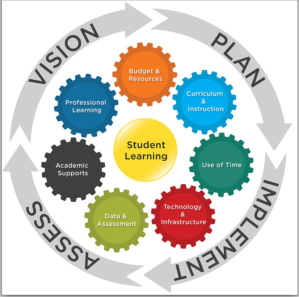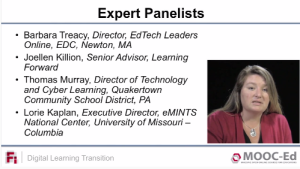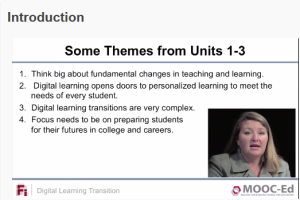DLT MOOC
18 Novembro
DLT MOOC is in the final week and I must confess that I have not been much involved in it. It has many teachers and schools directors involved, in the context of US education system. It has a strong feature of discussions going on, in which I tried to participate in the beginning. What impressed me in this MOOC was the high standard level of discussion, as well as the amount of contributions.
The participation in Project 24 School and District Self Assessment also led me to remain more as lurker than participant since this was addressed for US context: «participation by teams from schools, districts or other organizations, since having local colleagues work together to relate the lessons from the DLT MOOC-Ed to their own context makes the course even more valuable.»
«The following graphic shows the Digital Transition Vision-Plan-Implement-Assess cycle around the seven DLT planning elements, which are all centered on improving student learning. This graphic will be used as the organizer for the DLT MOOC-Ed.»
16 November
This MOOC proposed to participants to engage in Project 24 School and District Self Assessment
«As part of the MOOC-Ed, we encourage you to take the Project 24 School and District Self Assessment, developed by the Metiri Group for the Alliance for Excellent Education’s Project 24 Initiative. This survey will gauge your district’s readiness to begin implementing digital learning. It includes a series of questions designed to help you frame a vision for digital learning and recognize the elements of the Project 24 Framework. It then specifies how digital learning can help align your vision with the Project 24 elements to achieve higher college- and career-ready standards. You will receive a personalized report with your groups after completing the survey, and this will include your results and recommendations on where to apply your efforts.
Although we encourage you to take the self assessment as part of a team, many have also seen a benefit from taking it individually. Information on getting ready to take the assessment as part of a team and the survey can be found at www.digitallearningday.org/partners/project-24/self-assessment.»
9 November
Unit 6 essential questions propose to ask the following about your school or district:
- In order to successfully address your local goals and challenges (from Units 3 and 4), what needs to be done on your selected elements?
- What progress has your school or district already made on your selected elements?
- What strategies or next steps would you recommend to your school and district for making progress on you selected elements?
Unit 7 focused in Leadership, considering strategies for the effective leadership of digital learning transitions. The essential questions for this unit were:
- What leadership strategies are currently being used in your school or district digital learning transition?
- What are the strengths and weaknesses of the current local leadership strategies?
- What recommendations would you make to improve your local DLT leadership strategies?
2 November
Unit 5 addresses teacher training, namely the issues:
- How well prepared are teachers and administrators for the changes in their knowledge and practices required for a successful digital learning transition?
- How can effective professional development be provided to prepare teachers and administrators for the changing expectations involved in digital learning?
I cite some of the views in the MOOC, which I share:
- Fosters a deepening of subject-matter knowledge, a greater understanding of learning, and a greater appreciation of students’ needs;
- Centers around the critical activities of teaching and learning—planning lessons, evaluating student work, developing curriculum, improving classroom practices and increasing student learning;
- Builds on investigations of practice through cases that involve specific problems of practice, questions, analysis, reflection, and substantial professional discourse;
- Values and cultivates a culture of collegiality, involving knowledge and experience sharing among educators; and,
- Is sustainable, intensive, and continuously woven into the everyday fabric of the teaching profession, through modeling, coaching, and collaborations.
Other resources are recommended in this unit:
Darling-Hammond, L., Wei, R.C., Andree, A., Richardson, N., Orphanos, S. (2009). Professional Learning in the Learning Profession: A Status Report on Teacher Development in the U.S. and Abroad. National Staff Development Council. Pages 3-13. This section of the report provides an excellent summary of the key research findings that should inform professional development for educators. The rest of this report is also highly recommended.
Technology in Education: A Brief Introduction. (Video 12:59) Ruben Puentedura introduces key concepts relevant to professional development for digital learning, including his SAMR (Substitution, Augmentation, Modification and Redefintion) model of levels of technology integration, the TPACK (Technological, Pedagogical and Content Knowledge) framework (see TPACK.org listing under additional Additional Resources) and his new framework that builds upon the Horizon Report about emerging technologies for K-12 education that we reviewed in an earlier unit.
http://www.youtube.com/watch?v=rMazGEAiZ9c
Killion, J. Tapping Technology’s Potential. JSD: The Learning Forward Journal, February 2013, pp. 10-18. Summarizes ways in which technology can enhance professional learning and provides criteria for selecting technology-enhanced professional learning.
High-Impact Professional Development for Rural Schools. (Video 6:40) Edutopia report on the eMINTS (Enhancing Missouri’s Instructional Networked Teaching Strategies) professional development approach. After the video, the text provides more specifics and, at the end, links to professional development resources and the sample lessons used in the program.
Personalizing the Classroom Experience: Teachers, Librarians and Administrators Connect the Dots with Digital Learning. Project Tomorrow Speak Up National Findings, May 2012. This report documents that the ways educators are using technology to personalize their students’ learning reflects their own experiences with online learning, social networking, and digital content.
22 October
Unit 4 addresses:
- How can we effectively communicate our goals for digital learning, and the challenges to meeting those goals, with the members of our school or district community?
- What new insights and ideas have we gained about digital learning that will impact our work?
The video wraps-up issues from unit 1-3
A table of resources suggested by participants,
A repository of 464 Digital Learning tools was suggested by me.
15 October
Unit 3 addresses Goals and Challenges
An activity is proposed to the participants : Create your own statement, as an individual or a local team, to address the following questions for your school or district:
- What are the most important goals for updating teaching and learning in your classroom, school, district or organization?
- What are the biggest challenges you and your colleagues must address to achieve these goals?
More examples of schools that went digital:
- Mountainview Elementary School, Morgantown, West Virginia – The elementary school where Digital Learning Day began – http://youtu.be/GSEe9zCgJB0
- Cajon Valley Union Middle School District, CA – A middle school that emphasizes students as creators of media, not just consumers – http://youtu.be/86PzcKRh0p8
- City Arts and Technology High School, San Francisco, CA – A high school that focuses on deeper learning for all students. – http://youtu.be/6kRpQAocWWs
- Advantages of 1:1 Computing, NC – Interviews with middle and high school teachers in 1:1 classrooms in North Carolina. – http://vimeo.com/75512400
- New Tech High School, Cleveland, OH – Focuses on project-based learning enabled by technology. – http://vimeo.com/76711179
Examples from Texas Schools
- El Paso – http://www.youtube.com/watch?v=Faiq_IR0jOE&feature=share&list=PL692411994F3A0A9C
- ARP ISD – http://youtu.be/fpcOozoj0H8
- Floydada – http://www.youtube.com/watch?v=HMoR90-vFfY&feature=share&list=PL692411994F3A0A9C
- Irving ISD – http://www.youtube.com/watch?v=PRwusEf61Wc&feature=share&list=PL692411994F3A0A9C
7 October
Unit 2 is about Changing the Culture of Teaching and Learning
https://courses.mooc-ed.org/dlt2/unit?unit=3
Some examples of digital initiatives in USA were given such as:
- Maine Learning Technology Initiative, which began in 2002, giving all teachers and students of middle school a laptop. In 2010 was covering 226 middle schools – 29.570 students – 4.468 teachers; 66 highschools – 23.700 students – 7.401 teachers –http://youtu.be/rBAduBgV0LI
- Mooresville Grades School District, North Carolina – Digital conversion started in 2007 – laptops for 4.500 students and staff – grades 4-12. It reached the 2nd best position among schools in NC – http://youtu.be/EKYW6fD9DfE
- Klein ISD, Texas – 47.000 students in the District from disadvantageous background. Began introducing technology in late 90’s. It covers 47% of students. http://youtu.be/G_SOd4gVI3c
- Quakertown Community S.D., Pennsylvania – 5.500 students in District – BYOD initiative – http://youtu.be/adqwaFlEDQ4
Critical Challenges Infographic
Some articles were made available:
- Culture Builder
- Serious Challenges Facing District Leaders
- Model Research – National and State Perspectives
1 October
Digital Learning Transition (DLT) MOOC started on the 30th September, with the goals:
- Understand the potential of digital learning in K-12 schools;
- Assess progress and set future goals for your school or district; and
- Plan to achieve those goals.
The DLT MOOC-Ed is promoted by the Friday Institute for Educational Innovation at NC State University’s College of Education and the Alliance for Excellent Education’s Project 24. Dr. Glenn Kleiman and Dr. Mary Ann Wolf are the program directors, with many others contributing.
The DLT MOOC-Ed is divided into two parts, each consisting of four one-week sessions. The course begins on Sept. 30 and ends on Nov 24.
As this course is much focused on USA schools and education system, addressed to people with local or district responsibilities, I’ll be more of an observer, participating now and then, in spite of the discussions being very motivating. The discussion thread on «Most important changes needed in K-12 education» has very good quality posts. I found interesting the organization of big groups of discussion (sectioned by alphabetical name), considering the big number of enrollments.
Part I: Where Are We Heading? Goals for the Digital Learning Transition.
Unit 1: Envisioning Schools in the Year 2020 (September 30 – October 6). Participants further their thinking about the vision for DLT in their schools and their ability to communicate that vision to multiple stakeholder groups. The essential questions for this unit are:
- What are the most important ways we need to update K-12 education?
- When K-12 education is updated to fully incorporate digital learning, what will be different for students? What will be different for teachers?
Unit 2: Changing the Culture of Teaching and Learning (October 7 – 13). This unit focuses on the impact of digital learning on classroom practices and on expanding students’ opportunities to learn beyond the classroom walls. The essential questions are:
- How should our own schools and districts revise and expand when, where and how students have opportunities to learn?
- What are the major challenges to making these changes?
Unit 3: School and District Digital Learning Transitions (October 14 – 20). We now turn to case studies of schools and districts that have digital learning transitions well underway, looking at their goals, challenges, strategies and lessons learned. Participants also complete their first project on their recommendations for digital learning goals for their school or district. The essential questions are:
- What goals should we set for our local digital learning transition?
- Which of the strategies and lessons learned from the case studies can help us achieve our local goals?
Unit 4: Wrap Up of Part I (October 21 – 27). During this unit, participants provide constructive feedback to each other on their recommendations of digital learning goals for their schools and districts, considering both the goals and how they are communicated. They also complete the Part I discussions, crowdsource the most important lessons learned and complete a survey about the DLT MOOC-Ed. The essential questions for this unit are:
- How can we effectively communicate our goals for the digital learning transition with all the members of our school or district community?
- What new insights and ideas about digital learning will impact our work?


